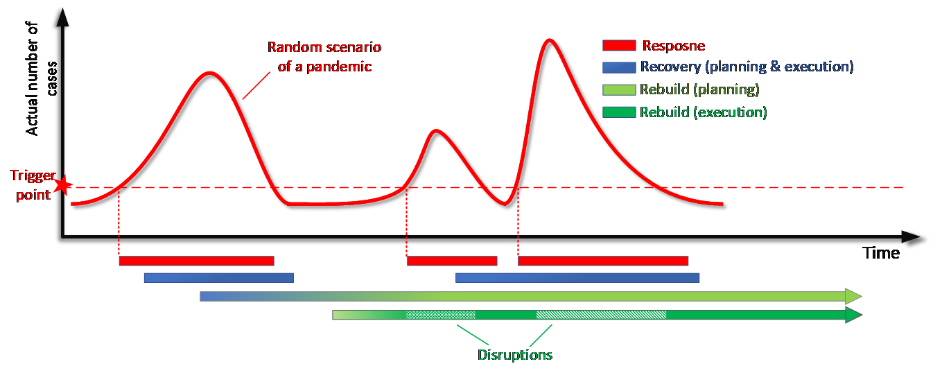Now that the UK is over the initial response stage to COVID-19, thoughts are turning to the recovery. Dr Ayham Fattoum explains how decision-making should be guided during this next phase. Dr Ayham Fattoum is a Lecturer in Disaster Operations Management.
Contrary to typical emergencies, two overlapping phases of recovery may be considered in the case of a pandemic. The first is the emergency recovery phase (henceforth recovery) which aims to enhance the viability and capability of the response system in the short-term. This emergency recovery is needed because the duration and the requirements of the response are unpredictable, so the system needs to continuously recover the depleting response system (resources, staffing, improving operations) and maintain the basic wellbeing of the system that is under pressure.
The second is the rebuild phase which is strategic and longer-term, and aims to build stronger, more resilient, and sustainable systems and societies. The figure below depicts a response scenario to a random pandemic which shows when to consider response, recovery and rebuild. The significance of this distinction is that decision-makers need to know what actions are appropriate in each stage of the pandemic.

COVID-19 presents a highly uncertain environment in terms of planning and executing recovery and rebuild. For the ‘new normal’ to be sustainable and resilient, decisions need to be vision-oriented, inclusive and feasible. Specifically, decision-making should be guided by seven key principles:
One: Vision
A series of short-term decisions over a lengthy crisis may build a situation that makes rebuild more challenging. For instance, response decisions may result in depleting or losing resources crucial for rebuild (e.g. financial, equipment, staff, volunteers, infrastructure, skills, and knowledge), or establishling behaviour, expectations, and norms that hinder a sustainable and resilient future.
Decision-making should, therefore, be guided by a vision during the response, recovery, and rebuild periods. Decision-makers can do this by asking the questions ‘What, reasonably, are we trying to achieve? What is our vision?’ The answer to this can be framed as a narrative that will form the goal and a guiding vision for the decisions made.
Two: Criteria
Criteria are the main themes that inform how the vision can be achieved and each criterion may be divided into manageable sub-criteria that contribute to achieving the relevant goals that are developed from the vision. The aim during the response as well as recovery stages is to continuously prioritise and enhance these criteria to ensure the system’s viability.
For instance, to achieve resilience against COVID-19, the system may need to achieve a sophisticated digital infrastructure, agile health services, a robust voluntary sector, and strong co-ordination across public agencies. In a highly complex context, the number of criteria can be vast and should be identified and prioritised considering their relevant contribution to the vision.
Three: Intuition
It is common to see leaders using their intuition to make decisions under pressure. Intuition can be an excellent complement to qualitative decision-making because it harnesses the knowledge and experience of people involved. However, this can also be criticised for being subjective or encouraging bias where people blindly follow intuition, ignoring contradictory advice.
Four: Context
Lessons learned from other countries and their practices are contextual and so their suitability should be evaluated for the relevant context. It may also be worth considering contextual differences within the same country or region, and to give local authorities the flexibility to adapt these measures according to their contexts.
For instance, the phone tracking and data collection measures to enforce lockdown in China are not immediately applicable to the UK because of the differences in culture, policies, and social values. However, these lessons may be modified to fit the context, as was done in some countries where phone tracking was done voluntarily.
Five: Ethics
Ethical decisions are considered in the light of a set of agreed moral values, such as respecting people’s wellbeing and dignity, the environment, justice, and protecting social solidarity. These values, however, are relative to context. For example, immigrant workers in Singapore live in high-density units with poor infrastructure compared to other urban areas. Equality issues and their consequences only surfaced after identifying these units as a main spread source of COVID-19.
Six: Engaging communities
Communities are key stakeholders because they are directly affected by many decisions. They are also a rich source of data and ideas for decision-making. Representatives of local communities should be involved in decision-making discussions and consulted on the feasibility of decisions, while digital platforms (e.g. social media) can be used to collect data and feedback from relevant communities.
For example, Singapore made available chatbots (chat robots) to people to express their worries and get suggestions on how to deal with the issues they faced.
Seven: Bias
Subjectivity and bias may be issues for qualitative decision-making because they involve people’s intuition, personal values, and opinion. In the decision-making literature, bias is often seen as a hindrance to robust decision-making and potential biases can be reduced by adopting a holistic decision-making process, meaning that the bigger picture is considered.
In practice, this may mean engaging with a wide range of stakeholders, but whom to include will depend on prevailing issues. For example, a short discussion between a small number of stakeholders may be necessary during the response phase, while a longer discussion with a wider range of partners may help to plan rebuild.


